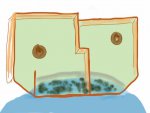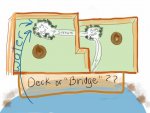Mmathis
TurtleMommy
- Joined
- Apr 28, 2011
- Messages
- 13,928
- Reaction score
- 8,103
- Location
- NW Louisiana -- zone 8b
- Hardiness Zone
- 8b
- Country

Some background info for those who don't know about my set-up. You can skip this part if you already know.
______________________________________________________________
I have box turtles, and have put a lot of work & planning into their habitats over the past few years. One MAJOR issue was their access to fresh water. Boxies are "land" turtles -- they only need a few inches of water to fulfill their needs. They can swim, to some degree, but they aren't made for an aquatic life, so anything deeper than a few inches can be fatal for them.
The problem was this: turtles are messy critters. They primarily use their water for soaking and as a potty. The usual method of providing water is to have something like a plant saucer filled with water that they can climb into. HOWEVER.....do you know how OFTEN you have to clean and refill a plant saucer when you have a caboodle of turtles using it several times a day? And how much of a pain this gets to be? If I went on vacation during the "turtle months," [when they're not "hibernating"], there's NO WAY my babies would have fresh, clean water -- MAJOR HEALTH CONCERNS!
So that's what lead me to the decision to build a pond. We've always wanted a pond, so it wasn't a difficult decision to make. Originally, it was just going to be something around a hundred or so gallons, but after research, I realized that the larger the water volume, the "easier" it would be to maintain a better water quality. Plus, more water meant that we could have fish! Yea!! [the pond is around 3000 gals]
But the BIGGEST problem was coming up with a way to have a pond that was 100% "TURTLE-SAFE!"
The solution was to make a "false bottom" for the section that was incorporated into their habitat. I won't go into the constructions details, but just to say that I used PVC pipe as a frame and support. I attached cedar fence planks to tie it into the walls of their enclosure, and to provide a PHYSICAL [boxies are escape artists] and VISUAL [if they can see the other side, they want to go there] barrier.
________________________________________________________________
It has worked out very well over the past year, but there are issues, and I'm now looking at a more permanent solution. Hopefully the pictures will help you understand.
LIST OF ISSUES:
1. Need to ditch the cedar -- looks nice, but EVERY time we get a good rain, tannins from the wood leech into the water, and I have cola-water. It was costing a fortune to have enough activated charcoal on hand to clear the tannins.
2. Not confident in the overall integrity of the PVC structure -- has been fine, so far, but since that area is a "bog," I end up walking on it. Plus it's heavy with pea gravel. Afraid that one of these days it's going to give out, and/or eventually that the weight is going to puncture the liner.
3. The area underneath the "false-floor" is open, so the fish have access there. That's good and bad. It gives them a nice hiding place, but essentially, I have no way of knowing what's going on under there. There is water circulating [since it's a "bog," I have water going from the pump via a PVC set-up], and the bottom is sloped so sediment will flow out. But what's REALLY going on? Do fish get trapped; go there to die....?
4. It's not really an efficient "bog," though the turtles LOVE it. For one thing, the gravel bed isn't that deep -- maybe 6 inches -- so not a lot of support for the plants.
_______________________________________
SOLUTION: I want to convert the area where the turtles live into a real bog! My thoughts were to remove all of the PVC support structures [after confining the turtles, of course]. Pull up the cement ramping I made [it's what bridges the gap between their "land" and the water/bog]. Do a little more excavating and sculpting. Then build a berm or wall that would define the boundary of the NEW bog. If necessary, seam in some additional liner -- which may not be an issue, since the NEW bog will actually take up a more shallow footprint.
==========================
AND THIS IS WHERE I NEED HELP.........
QUESTIONS / ISSUES / CONCERNS: I guess, during the "construction" phase, I could let down some water, then pull the liner back to have access after removing the PVC. I have decided that I want the LINER TO GO OVER the berm/wall rather than build something on top of the liner.
1. Would building a dirt berm to the height needed work? Then pull the liner over it to complete the bog...
2. Would it work any better to use cement block and/or decking wood to build the wall?
-- naturally, I want the wall to be secure and not collapse -- but I'm "construction" challenged about things like this --
3. But my biggest issue is how to add a "turtle fence" [NOT made of wood, this time!] to go on top of the berm, to confine the turtles. It has to be around 16" tall and escape proof -- nothing that can be climbed and something the turtles can't see through [along the lines of what's there now].
-- how to DO it; what to use......
So, now for the pictures:
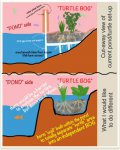
A "visual" of what's there now, and where I want to go. Not to scale, but the following pics will give you an idea of what it REALLY looks like
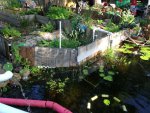
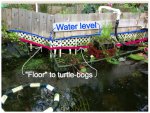
First pic is pond, full. Second pic is after a draw-down -- you can sorta see how the "false floor" looks.
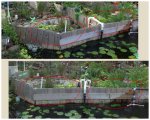
I just realized that an iOS upgrade gave me the ability to take panoramic pics! Yea! The areas circled in "red," are where the "turtle bogs" are now. The habitats are separated for boy turtles and girl turtle, each having a separate area. I plan to keep that same "floor plan" with the renovation. You can see the water distribution for the "bog."
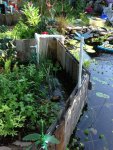
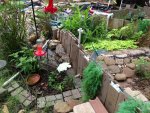
Side-views, from both ends. First pic is the "boy" side, and second pic is the "girl" side.
______________________________________________________________
I have box turtles, and have put a lot of work & planning into their habitats over the past few years. One MAJOR issue was their access to fresh water. Boxies are "land" turtles -- they only need a few inches of water to fulfill their needs. They can swim, to some degree, but they aren't made for an aquatic life, so anything deeper than a few inches can be fatal for them.
The problem was this: turtles are messy critters. They primarily use their water for soaking and as a potty. The usual method of providing water is to have something like a plant saucer filled with water that they can climb into. HOWEVER.....do you know how OFTEN you have to clean and refill a plant saucer when you have a caboodle of turtles using it several times a day? And how much of a pain this gets to be? If I went on vacation during the "turtle months," [when they're not "hibernating"], there's NO WAY my babies would have fresh, clean water -- MAJOR HEALTH CONCERNS!
So that's what lead me to the decision to build a pond. We've always wanted a pond, so it wasn't a difficult decision to make. Originally, it was just going to be something around a hundred or so gallons, but after research, I realized that the larger the water volume, the "easier" it would be to maintain a better water quality. Plus, more water meant that we could have fish! Yea!! [the pond is around 3000 gals]
But the BIGGEST problem was coming up with a way to have a pond that was 100% "TURTLE-SAFE!"
The solution was to make a "false bottom" for the section that was incorporated into their habitat. I won't go into the constructions details, but just to say that I used PVC pipe as a frame and support. I attached cedar fence planks to tie it into the walls of their enclosure, and to provide a PHYSICAL [boxies are escape artists] and VISUAL [if they can see the other side, they want to go there] barrier.
________________________________________________________________
It has worked out very well over the past year, but there are issues, and I'm now looking at a more permanent solution. Hopefully the pictures will help you understand.
LIST OF ISSUES:
1. Need to ditch the cedar -- looks nice, but EVERY time we get a good rain, tannins from the wood leech into the water, and I have cola-water. It was costing a fortune to have enough activated charcoal on hand to clear the tannins.
2. Not confident in the overall integrity of the PVC structure -- has been fine, so far, but since that area is a "bog," I end up walking on it. Plus it's heavy with pea gravel. Afraid that one of these days it's going to give out, and/or eventually that the weight is going to puncture the liner.
3. The area underneath the "false-floor" is open, so the fish have access there. That's good and bad. It gives them a nice hiding place, but essentially, I have no way of knowing what's going on under there. There is water circulating [since it's a "bog," I have water going from the pump via a PVC set-up], and the bottom is sloped so sediment will flow out. But what's REALLY going on? Do fish get trapped; go there to die....?
4. It's not really an efficient "bog," though the turtles LOVE it. For one thing, the gravel bed isn't that deep -- maybe 6 inches -- so not a lot of support for the plants.
_______________________________________
SOLUTION: I want to convert the area where the turtles live into a real bog! My thoughts were to remove all of the PVC support structures [after confining the turtles, of course]. Pull up the cement ramping I made [it's what bridges the gap between their "land" and the water/bog]. Do a little more excavating and sculpting. Then build a berm or wall that would define the boundary of the NEW bog. If necessary, seam in some additional liner -- which may not be an issue, since the NEW bog will actually take up a more shallow footprint.
==========================
AND THIS IS WHERE I NEED HELP.........
QUESTIONS / ISSUES / CONCERNS: I guess, during the "construction" phase, I could let down some water, then pull the liner back to have access after removing the PVC. I have decided that I want the LINER TO GO OVER the berm/wall rather than build something on top of the liner.
1. Would building a dirt berm to the height needed work? Then pull the liner over it to complete the bog...
2. Would it work any better to use cement block and/or decking wood to build the wall?
-- naturally, I want the wall to be secure and not collapse -- but I'm "construction" challenged about things like this --
3. But my biggest issue is how to add a "turtle fence" [NOT made of wood, this time!] to go on top of the berm, to confine the turtles. It has to be around 16" tall and escape proof -- nothing that can be climbed and something the turtles can't see through [along the lines of what's there now].
-- how to DO it; what to use......
So, now for the pictures:

A "visual" of what's there now, and where I want to go. Not to scale, but the following pics will give you an idea of what it REALLY looks like


First pic is pond, full. Second pic is after a draw-down -- you can sorta see how the "false floor" looks.

I just realized that an iOS upgrade gave me the ability to take panoramic pics! Yea! The areas circled in "red," are where the "turtle bogs" are now. The habitats are separated for boy turtles and girl turtle, each having a separate area. I plan to keep that same "floor plan" with the renovation. You can see the water distribution for the "bog."


Side-views, from both ends. First pic is the "boy" side, and second pic is the "girl" side.

